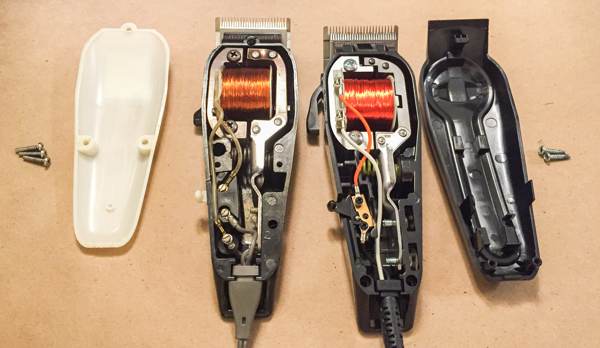Hair clipper teardown: comparing changes in design after 50 years

Steve Hoefer broke his 50-year-old electric hair trimmer, so he bought the latest model. He opened it to get a peek inside, and wrote about the similarities and differences.
The screws holding the faceplate have decreased from three to two, and they go through the other side, but they're the same self-tapping screws in both. Same Phillips head, same diameter and length, same thread pitch.
And the mechanism in the interior is virtually identical.
The way it works is by utilizing the 60Hz oscillation of AC power to run an electromagnet. AC power inverts the polarity of the electricity 60 times a second. When you use this to run an electromagnet, it effectively turns it on and off every time the power alternates. In the clipper, the electromagnet is the big orange thing near the front, wound with all of the copper wire and a C-shaped ferrous core that's fastened securely to the case. The motion is created by the vaguely question-mark-shaped piece of metal on the right side. It's only attached at the base of the unit near the cord with two beefy screws. (The cover in the 2016 version blocks access to the screws from the outside, which seems fair. Unscrewing them without opening the case would be bad. But they also made them pentalobe screws, which means they don't want owners touching them.) The straight part of the question mark is a very sturdy flat spring, which attaches to another C-shaped (or rather e3/4-shaped) block of metal at the front. Below that (unseen in this pic) is a little knob of Delrin that guides the blade. The metal block is what the electromagnet moves, and the spring is powerful enough to move it back before the next cycle, 60 times a second. It only moves a millimeter or two, but that's all it needs. There's no loss of efficiency converting rotation to lateral motion, no extra friction. Electromagnets can be incredibly powerful, and the only parts to wear out is the spring, which is incredibly robust and will wear slowly due to its limited motion. (And the blades, but even they use wear as a mechanism to sharpen themselves.)